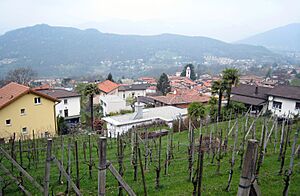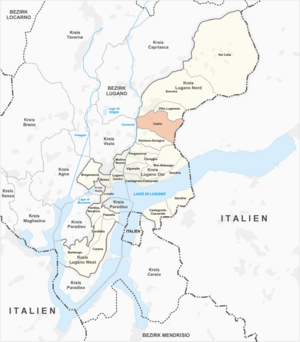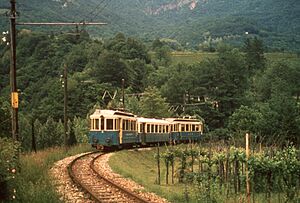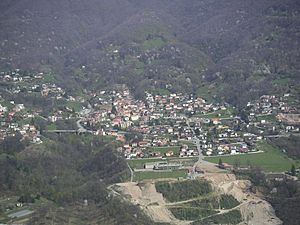Cadro facts for kids
Quick facts for kids
Cadro
|
||
|---|---|---|
|
Quarter
|
||
 |
||
|
||
 |
||
| Country | Switzerland | |
| Canton | Ticino | |
| District | Lugano | |
| City | Lugano | |
| Area | ||
| • Total | 4.45 km2 (1.72 sq mi) | |
| Elevation | 473 m (1,552 ft) | |
| Population
(2010-12-31)
|
||
| • Total | 1,976 | |
| • Density | 444.0/km2 (1,150.1/sq mi) | |
| Postal code |
6965
|
|
| SFOS number | 5163 | |
| ISO 3166 code | CH-TI | |
| Surrounded by | Canobbio, Lugano, Sonvico, Valsolda (IT-CO) | |
Cadro is a part, or "quarter," of the city of Lugano in Switzerland. It used to be its own separate town, called a "municipality." Cadro is located in the Lugano district within the Ticino canton.
On April 14, 2013, Cadro joined with several other towns like Bogno, Carona, and Sonvico to become part of the larger city of Lugano.
Contents
History of Cadro
Cadro was first mentioned in old writings in the year 735. Back then, it was called Cadelo. In 854, during the time of the Lombards (a Germanic people who ruled parts of Italy), Cadro was known as a Vicus, which means a small village or settlement.
During the Middle Ages (a period from about 500 to 1500 AD), some important landowners in Cadro included a monastery in Milan and another one in Como. There was also a hospital in Lugano that owned land here. The village of Dassone was once part of Cadro, mentioned in 1591, but it was later abandoned, possibly because of a serious illness like the plague.
The village church, called S. Agata, was first mentioned in 1366. It has beautiful stucco work (a type of decorative plaster). The church was fixed up in 1603 and again in the 20th century. Until 1599, it was part of the larger church area of Sonvico. Later, Cadro became its own independent church area.
For a long time, people in Cadro earned money from farming. They also received money from family members who had moved away to work. In 1911, Cadro got a train connection with the Lugano–Cadro–Dino railway. Since the 1960s, the number of people living in Cadro has grown a lot, and it has become a busy part of the Lugano area.
Geography of Cadro
Before it joined Lugano, Cadro covered about 4.5 square kilometers (about 1.7 square miles). A good part of this land, about 15.3%, was used for farming. Most of the area, about 72.6%, was covered by forests.
About 17.7% of the land was developed with buildings and roads. A very small amount, 0.2%, was rivers or lakes. The rest, 0.7%, was land that couldn't be used for anything.
In the built-up areas, about 9.7% was homes and other buildings. Roads and transportation took up 1.8%. There were also areas for power and water, and some parks and sports fields. The forests were mostly dense woods, with a small part having orchards or groups of trees. For farming, some land was used for crops, some for orchards, and some for pastures where animals graze.
Cadro is located in the Lugano district, at the bottom of a mountain range called the Denti della Vecchia, in the Cassarate valley.
Cadro's Coat of Arms
The coat of arms for Cadro is a green shield with a silver unicorn on it. The unicorn is shown jumping, and it has a golden crown around its neck. A "blazon" is the special way of describing a coat of arms using specific words.
People of Cadro (Demographics)
As of 2011, Cadro had a population of 2,037 people. About 13.9% of the people living there in 2008 were from other countries. Over ten years, from 1997 to 2007, the population grew by about 20.9%.
Most people in Cadro speak Italian (85.9%). The second most common language is German (7.2%), and Albanian is third (1.3%).
In 2008, the population was almost evenly split between males and females. There were slightly more males (50.2%) than females (49.8%).
In 2008, 14 babies were born to Swiss citizens and 2 to non-Swiss citizens. In the same year, 12 Swiss citizens and 1 non-Swiss citizen passed away. Overall, the number of Swiss citizens increased slightly, and the number of non-Swiss citizens increased more due to people moving into Cadro.
Looking at the ages of people in Cadro in 2009:
- About 9.4% were children aged 0-9.
- About 11.2% were teenagers aged 10-19.
- About 10.7% were young adults aged 20-29.
- The largest group was adults aged 40-49, making up 19.3% of the population.
- About 12.1% were seniors aged 60-69.
- About 3.1% were over 80 years old.
In 2000, there were 639 homes in Cadro, with about 2.5 people living in each home on average. Most of the buildings (74.5%) were single-family homes.
The following timeline shows how the population of Cadro has changed over many years:

Important Heritage Sites
The Parish Church of S. Agata in Cadro is considered a very important cultural site in Switzerland. It is listed as a heritage site of national significance.
Economy of Cadro
In 2007, the unemployment rate in Cadro was 2.87%, meaning a small percentage of people looking for work couldn't find a job.
In 2005, people in Cadro worked in different types of jobs:
- Primary sector: 16 people worked in jobs like farming, fishing, or forestry. There were 5 businesses in this area.
- Secondary sector: 89 people worked in manufacturing or construction. There were 20 businesses in this area.
- Tertiary sector: 362 people worked in services, like shops, offices, or tourism. There were 44 businesses in this area.
Overall, 933 residents of Cadro were employed, and about 33.8% of them were women.
In 2000, many people traveled for work. About 422 workers came into Cadro for their jobs, while 708 workers left Cadro to work in other places. This means more people left Cadro for work than came in. About 7.7% of workers used public transportation, and 56.2% used a private car to get to work.
As of 2009, there was one hotel in Cadro.
Religion in Cadro
Based on the 2000 census, most people in Cadro were Roman Catholic (75.6%). About 7.1% belonged to the Swiss Reformed Church. A smaller number of people (12.35%) belonged to other churches not listed in the census, and about 4.95% did not state their religion.
Education in Cadro
Switzerland is known for having a well-educated population. In Cadro, about 73.7% of adults aged 25-64 have finished either advanced high school education or gone on to higher education, like a university or a specialized college (called a Fachhochschule).
In 2009, there were 341 students in Cadro. The education system in Ticino, the canton Cadro is in, offers up to three years of optional kindergarten. In Cadro, 55 children were in kindergarten.
The primary school program lasts for five years. In Cadro, 90 students attended regular primary schools, and 1 student attended a special school.
For lower secondary school, students have a few choices:
- A two-year middle school, followed by a two-year program to prepare for an apprenticeship (learning a trade). There were 97 students in this middle school.
- A four-year program to get ready for higher education. 49 students were in this program.
After lower secondary school, students can choose different paths to prepare for a job or university. Some students learn a trade while working (an internship or apprenticeship), which takes three or four years. Others go to school full-time for a year or part-time for longer, then do an internship. In Cadro, 16 students were full-time vocational students, and 29 were part-time.
There is also a professional program that lasts three years. This program prepares students for jobs in fields like engineering, nursing, computer science, or tourism. In Cadro, 4 students were in this program.
In 2000, 30 students who lived in other towns came to school in Cadro. At the same time, 195 students who lived in Cadro went to schools outside the town.
See also
 In Spanish: Cadro para niños
In Spanish: Cadro para niños






